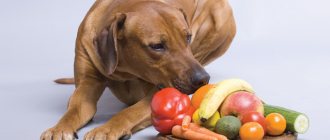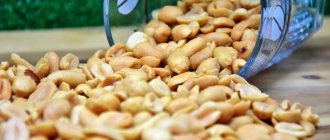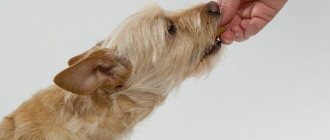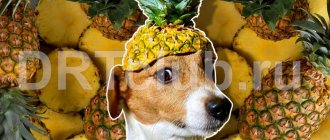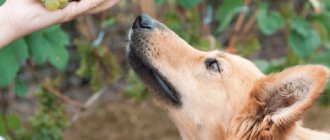Even if a pet eats balanced food, the owner still sometimes wants to pamper it with natural food. What can we say about those who feed animals with food from their table.
It’s worth finding out whether watermelon can be given to dogs. The berry is healthy, but feeding it to four-legged friends is not always allowed.
Beneficial features
Watermelon contains many useful substances:
- potassium;
- pectins;
- phosphorus;
- iron;
- calcium;
- carotene.
The diuretic properties of the product are due to the presence of potassium salts in it, which prevents the formation of kidney stones and removes sand. Iron and folic acid improve blood circulation and normalize hemoglobin levels.
The fruit stimulates metabolic processes and has a beneficial effect on liver function. The berry is recommended for use in cases of chronic hepatitis, biliary dyskinesia, and cholecystitis.
Fiber cleanses the intestines and stimulates peristalsis, so it is recommended to feed dogs watermelon after completing a course of antibiotics or poisoning with aggressive substances.
Miracle berry contains lycopene, which suppresses malignant processes.
Watermelon is also good for pregnant dogs. With its help, hemoglobin increases, which often falls after childbirth. The fruit stimulates lactation.
Pekingese, Husky and other breeds
There is a common myth that watermelon should not be given to small breeds of dogs and, for some reason, huskies. In fact, this is not true. All dogs - from a huge Great Dane to a tiny Yorkshire Terrier - react to this berry in the same way. Another thing is that the dose of treats, of course, needs to be calculated individually . You should treat your Yorkie or Chihuahua in very microscopic doses.
Important! The smaller the dog, the more destructive the effects of poisoning are on it. So, if you are not sure that the watermelon is normal, you really shouldn’t feed it to small breeds.
Is it possible to peel
Watermelon rinds should not be given to your dog. The animal chews them poorly, swallowing them in large pieces. Hard peel can damage the intestinal walls.
The result is diarrhea with blood in the feces. The maximum concentration of nitrites and nitrates is observed in the crust.
It is impossible to know for sure that the berries were grown without their use.
Isn’t this a “photo-toad”?
Looking at the dog's happy face in the photographs, many do not believe that these are real photos. Some people think that the author of the photo did a good job on it, creating an absurd composition.
The other part is absolutely sure that the photo is real. And to prove its veracity, they cite as an example a list of their pets’ favorite vegetables and fruits.
But more often, four-legged owners are concerned about whether dogs eat watermelon. It cannot be said that all predators love to feast on melons. But there are definitely people who can’t be pulled away from watermelons by the ears.
Rules of use
Before eating, the berries must be washed, seeds and peel removed. The pet should be fed in small portions half an hour before the main meal.
The fruit cannot be mixed with other products. It is incompatible with basic foods, milk and fermented milk products.
If the dog wants watermelon, but has not tried it before, then the fruit should be cut into small pieces, giving a maximum of 40 g.
If itching, sneezing, or diarrhea occurs, this food is excluded from the diet. In the absence of such a reaction, the portion is gradually increased to 100 g.
Frequency of use
You should not feed your dog watermelon often. It is enough to pamper your pet with a fragrant treat 3-4 times a week.
Despite the enormous benefits of the berry, its excessive consumption can negatively affect the condition of the dog. The product contains a large amount of fructose, and the body enters a lot of sugar, which is poorly absorbed.
Who shouldn't
Owners of miniature dogs are wondering if Yorkies can eat watermelon. Veterinarians respond with a categorical refusal. This berry can cause allergies in representatives of the breed, so it should be completely excluded from the menu.
Additionally, sweet treats should not be offered to puppies until they are three months old. The digestive system of these crumbs has not yet formed, so the berry can cause diarrhea.
Watermelons are tasty, perfectly quench thirst, and therefore dogs often like them. Veterinarians note that they are allowed to be used for dog meals, but this should be done very carefully and in small portions.
Possible consequences of use
Negative changes in a dog’s body can occur for 2 reasons:
- poisoning;
- allergy.
An allergic reaction to melons rarely occurs. It is more severe in pets than in people. The symptoms of allergies are similar to poisoning. The veterinarian should be called immediately after the animal’s condition worsens.
Poisoning develops in the following cases:
- excessive concentration of nitrates, which negatively affect the dog’s condition;
- accumulation of pathogenic microorganisms due to violation of storage rules.
In case of poisoning you must:
- give the animal a weak solution of potassium permanganate and warm water;
- rinse the stomach until there is clean water in the vomit and feces;
- give a sorbent (dosage is calculated by a veterinarian);
- make sure that the dog drinks as much as possible, toxins will be released along with the urine, and dehydration will be prevented.
Individual reaction
Often a dog eats watermelon with pleasure, but the owner needs to carefully monitor the animal’s reaction. Sometimes the berry causes allergies, because animals, like people, have individual intolerance. The slightest manifestation of discomfort, a rash and a constant desire to scratch are signs that you should refuse the treat. In addition, consumption of watermelon can cause diarrhea in some dogs.
Why do dogs have their ears and tails docked and what breeds do it?
Watermelon pulp is sweet, juicy, and contains a lot of glucose, which dogs’ gastrointestinal tract is unable to absorb. That is why excess pulp can cause a deterioration in the quality of blood.
Important! It is unacceptable to treat pregnant or lactating bitches with watermelons.
The first acquaintance with watermelon should be careful; no one is immune from an allergic reaction.
Contraindications for use
Sometimes the consumption of melons and melons is contraindicated for dogs. They will have to be abandoned in the following cases:
- disturbance of urine outflow;
- frequent diarrhea;
- the presence of large kidney stones;
- diabetes;
- pancreatitis.
It is recommended to undergo an ultrasound examination to evaluate the condition of the kidneys. If sand is detected, a sweet berry will help eliminate the problem.
If there are large stones, there will be no positive changes. On the contrary, the animal will experience severe pain.
It is not recommended to give the fruit to puppies under 3 months . At this time, their digestive system is in the process of formation. After eating melons, diarrhea appears. Watermelon should not be given to dogs over the age of eight because it may cause indigestion.
How much watermelon pulp can be fed to animals?
Do not give animals tasty treats in large quantities. The serving size is set individually and depends on the dog’s body weight. A few small pieces are enough for a small individual or dwarf breed; an adult shepherd dog can be given 2-3 full-sized pieces. Naturally, properly prepared:
- wash the berries thoroughly before cutting;
- separate the crust from the pulp;
- remove all seeds (1-2 will not harm, but more is undesirable);
- cut into portions (2-3 cm).
We advise you to observe during the first feeding for the presence of allergic and other negative reactions. If the animal starts to itch or sneeze, the berry is not suitable for it.
We recommend waiting 1.5 - 2.0 hours after the main meal. Animals should perceive watermelon as a tasty treat that must be earned!
Golden mean
And yet, what should you do if a dog loves watermelon, happily wags its tail, smelling the tempting aroma, and looks longingly at the process of cutting a huge berry in a dense green peel?
You should probably trust your pet's wishes. If an animal shows its desire to chew a little plant food, then there is a reason to give in to it. And to the question “Can a dog have a watermelon?” Most veterinarians answer positively. But with a caveat: only without fanaticism.
In addition to watermelon, the predator must receive daily cereals, boiled vegetables, meat and other products, the majority of which are proteins.
Video “Dog eats watermelon”
In this video you will see how a dog can eat the world's largest berry with appetite.
(Watching Eye)
Was this article helpful?
Thank you for your opinion!
The article was useful. Please share the information with your friends.
Yes
No
X
Please write what is wrong and leave recommendations on the article
Cancel reply
Rate the benefit of the article: Rate the author ( 2 votes, average: 5.00 out of 5)
Discuss the article:
Is human food a taboo or an exception to the rule?
In human society, since ancient times, the ritual of food has played a vital social role. This is a sign of acceptance, love, friendliness and affection - which is why it is so difficult for us to resist giving our beloved pet a treat from time to time.
And you don’t have to deny yourself this! Only treats should be an addition to the main diet, occupying no more than 10% of its total volume
And of course, it is very important what exactly to treat
A piece of boiled meat without salt, a slice of low-fat high-quality cheese, a spoonful of cottage cheese or yogurt without additives, a slice of apple - all this can be offered to a dog or cat for following a command or just like that, for mutual pleasure.
List of prohibited foods for dogs and cats
However, there are a number of products that should not enter your pet’s stomach even from time to time, as they are not only harmful, but also dangerous. Among them:
- Bones, especially those that have been cooked. High temperatures make them brittle, and when chewed, they break into small pieces with sharp edges that can damage the gastrointestinal tract.
- Chocolate. Cocoa beans contain theobromine, which is toxic to dogs and cats. Dark chocolate, which has a high content of cocoa beans, is especially dangerous. Even one piece after some time can lead to arrhythmia, seizures and death.
- Onion. Contains disulfide, which destroys red blood cells in pets, leading to anemia.
- Raw fish, especially river fish. Can be a source of parasites, such as cat fluke, and also contains thiaminase, which destroys vitamin B1. With regular consumption, hypovitaminosis develops, leading to disorders of the nervous system.
- Grapes are a relatively recent addition to the list of strict prohibitions. Studies have linked consumption of the fruit to impaired kidney function in dogs. It is not yet clear what substance in grapes causes poisoning and in what doses the toxic effect is manifested, but it is better to avoid treating your dog with this fruit altogether. No studies have been conducted on cats, but here too it is better to be on the safe side.
- Xylitol is a common sweetener, often found in chewing gum, diet cookies, etc. It does not cause any harm to humans; in dogs it causes a decrease in blood glucose, impaired liver function, and seizures.
- Avocados contain persin, a toxin that can cause serious gastrointestinal distress in dogs and cats.
- Alcohol, as they say, is harmful in any quantity. Ethanol is a carcinogen, but while humans have enzymes that can break it down into safer compounds, these do not exist in the bodies of cats and dogs, which do not have a frugivorous evolutionary past. They immediately get serious alcohol poisoning.
What are the benefits of pomegranate?
Pomegranate
has many useful properties. It strengthens the cardiovascular system, improves thyroid function and blood composition, including significantly helping to increase hemoglobin. The fruit has antibactericidal and anti-inflammatory effects, it is effective in the prevention of tuberculosis.
Interesting materials:
What is percale bedding? What is percale fabric? What is a personal website? What is a primary genre? What is the first paragraph of text? What is a Zen dog? What is nail pigment? What is pigment in cosmetics? What is a website pixel? What is a pixel in arbitration?
Summarizing
Many people are confident that dogs can decide for themselves how to eat and will never beg for or eat harmful and dangerous foods. It is not true. Animals cannot assess the degree to which a particular substance is needed in their body. If a dish or product has an attractive smell, the pet will try to get food in any way.
From the first days when the puppy appeared in the house, owners must strictly prohibit him from stealing from the table
Also, the owner of the dog and his family members must agree that no one will feed the animal from the table or from hand, out of pity for the “sad hungry eyes,” offering the pet forbidden food. Without handouts, the dog will feel healthy and live a long life, and even a small piece of chocolate can bring great grief to a family that has unexpectedly lost a beloved dog.
Strictly prohibited products
Let's now figure out what absolutely cannot be given to dogs. This list will be slightly longer than in the case of permitted products.
You cannot feed your four-legged friend the following types of food:
- grapes and raisins. Signs of poisoning will appear within a few hours;
- seasonings and spices. They cause thirst, and can also provoke intestinal volvulus and dilation of the stomach. Spices negatively affect the animal’s sense of smell;
- smoked meats, pickles and spicy dishes. They contain a lot of fat and salt. They can provoke the development of inflammation of the pancreas;
- raw fish and bird bones. Such elements easily get stuck in the throat and can cause choking, bleeding and inflammation. In addition, helminths and other parasites enter the dog’s body with raw bones;
- raw meat. It is a source of parasites and infectious diseases. It is allowed to give only meat that has been well frozen (stayed in the freezer for 4–5 days). Before your pet eats such meat, the product is cut into small pieces and doused with boiling water. But even such actions do not guarantee complete safety;
- fatty meat scraps. It can provoke obesity and also contributes to the development of pancreatitis. You can feed the dog only pulp, as well as fragments with a small content of cartilage, veins and layers;
- potato. Once eaten, potatoes can cause diarrhea;
- chicken raw eggs. Through them, your pet can contract the pathogen salmonellosis. This product should only be given boiled.
It was already said a little above that dogs are not allowed to feed all types of fish.
It is strictly forbidden to give them river fish, which consists of a large number of bones. Also, river species are often affected by helminths and other parasites.
It is not recommended to feed dogs fruits that contain seeds.
Before feeding, they must be pitted.
If apricots, cherries or plums enter the animal's body, they can cause blockage of the digestive tract or poisoning, since the pits contain poison (cyanide).
You should not feed your pets sweets, candies, chocolate or give them coffee beans.
For four-legged pets, these products are real poison. They provoke serious poisoning.
Moreover, a fatal outcome is quite possible. Death occurs when eating sweets at a dose of 0.3 g per 1 kg of animal weight.
In addition, salt is a prohibited product.
With its regular use, an imbalance of electrolytes and disruption of water-salt metabolism occurs.
Human vitamins and mushrooms are also prohibited. It is not recommended to add onions and garlic to your diet, as they can cause anemia.
In small and one-time quantities, the negative consequences of consuming onions do not appear. You should be more careful with garlic.
The food given to your pet must be fresh and unspoiled. Moldy food, as well as food that has expired, will cause severe poisoning.
It is also strictly forbidden to pour alcoholic and carbonated drinks into dogs' bowls.
Alcohol causes paralysis of the nervous system and leads to heart failure.
At the same time, hops and ethanol provoke severe intoxication of the body, which can be fatal.
As you can see, dogs should not be given a rather impressive list of products.
However, to remain healthy and active, it is enough for the dog to eat foods from the approved list.
Remember that the animal must additionally receive mineral supplements and vitamin complexes.
